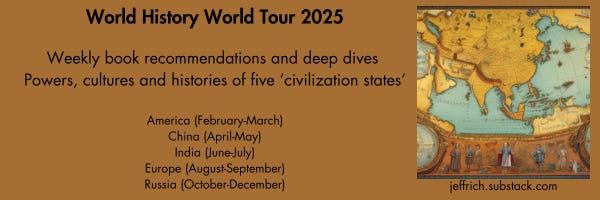Upending the Empire and Rebuilding the Republic
China Deep Dive III (1900-1935): Klaus Mühlhahn, Making China Modern
Welcome to the third instalment of my eight-week deep dive into Klaus Mühlhahn, Making China Modern: From the Great Qing to Xi Jinping. This deep dive series complements the China leg of my World History tour by reading one leading scholarly history of modern China.
The third instalment looks at the modern China’s turbulent history from the Boxer Rebellion to the start of what we think of as World War Two, but which military historian Richard Overy has retitled the “Great Imperial War 1931 to 1945”.
Historian John Darwin refers to the period 1910 to 1945 as the Crisis of the World. The world was in perpetual crisis from 1910 to 1945, not only in Europe. Within China this period saw the final fall of the Qing dynasty, the formation of a national republic, internal disorder and civil war, bitter disputes with external empires, cultural renewal along many vectors, and engulfment in military conflict with its ‘little brother’ Asian empire, Japan. It was a world shaking four decades, in which modern China was shaken and formed.
The Qing Dynasty fell in 1911, despite last-minute reforms, in a Revolution that began a period of experiment, rivalry for power, and disorder. Many national and modernist ideas were catalysed in the May Fourth and New Culture movements and galvanised by global reactions to the Versailles Peace Conference. In the absence of central authority, modernism thrived in cities like Shanghai, but military government and banditry prevailed in most regions. Disorder continued into the 1930s when the frail, fragmented China fell into war with Japan and civil war between Nationalists and Communists. On the brink of disaster in 1934, Mao and the Communist Party of China began their Long March to Revolution, History and Legend.
BURNING ARCHIVE CHANNEL NEWS
Today I published my interview with Norwegian international affairs expert Glenn Diesen: Peace After NATO: Glenn Diesen on Ukraine, Eurasia, Australia, and the Danger of Alliances. Glenn Diesen reveals the spectre haunting Ukraine, Europe, Eurasia, and Australia: NATO. Australian readers will be especially interested in his comments on Australian foreign policy.
On Monday I published my video commentary The end of globalization (as we know it) ... I guess. It explains how quality global history understands globalization and why Donald Trump’s tariffs—or anything Donald Trump does really—do not spell “the end of globalization.
On Saturday on Substack, I will share two outstanding books by the historian Rana Mitter on China’s experience of war, revolution, and nation in the first half of the century.
China Deep Dive III: Upending the Empire and Rebuilding the Republic
But first let’s dive deeper into Klaus Mühlhahn, Making China Modern: From the Great Qing to Xi Jinping to understand how China’s modern history does not begin in 1949.
Mühlhahn analyses China’s experience of this world and domestic crisis in two chapters:
Upending the Empire, 1900-1919 (pp. 209-247)
Rebuilding during the Republican Era, 1920-1937 (pp. 248-297).
Join as a paid subscriber to learn how this period made China modern.




